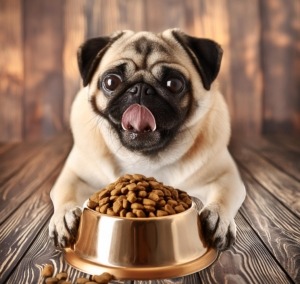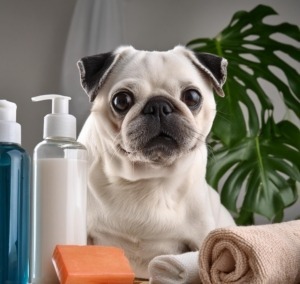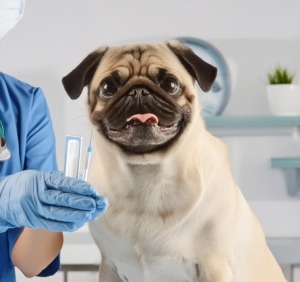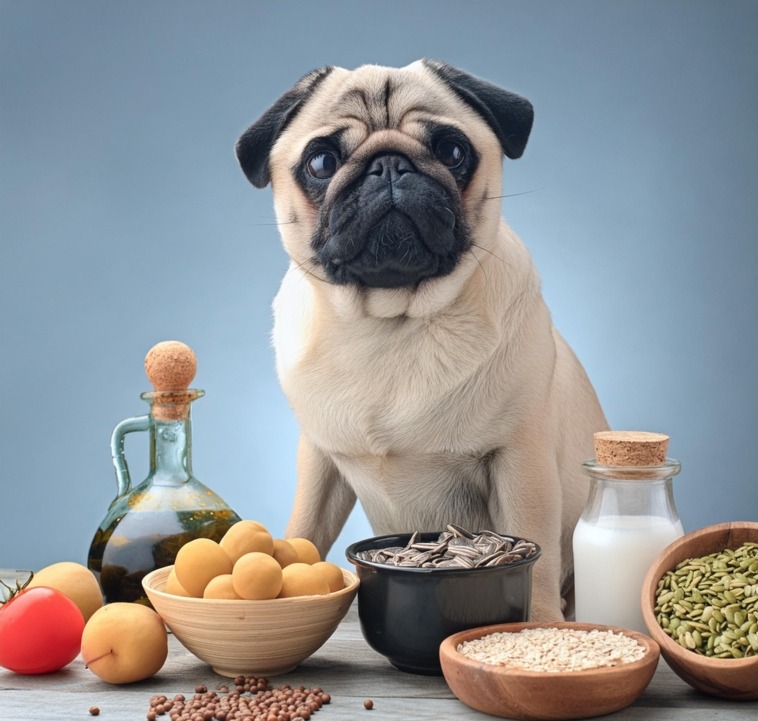Last updated on September 20th, 2024
Here’s an overview:
Introduction to Pug Health and Happiness
Understanding the Pug’s Unique Health Considerations
Creating a Balanced and Nutritious Pug Diet
Why Regular Exercise Is Important?
Becoming an Expert on Grooming for best Pugs Care
Protecting Your Pug from Common Parasites
Looking after Your Pug’s Respiratory Health
Socialization and Mental Health: Stimulating Your Pug’s Mind
Training and Behavior Tips for a Well-Mannered pugs
Addressing Pug’s Common Health Issues Early
The Role of Regular Veterinary Check-Ups
Preventing Obesity in Pugs Through Proper Care
Learn how to assess ideal body condition
Aging with Grace: Senior Pug Care Essentials
Creating a Safe and Pug-Friendly Home Environment
Conclusion: A Summary for a Joyful Life
Introduction to Pug Health and Happiness
When taking care of one, it is necessary to take more than just basic needs into account. These special little dogs have their own health issues due to their “squashed” faces -brachycephalic-, cute behavior, that can also be vulnerable sometimes. Such pets thrive on fondness, consistent treatment, as well as protection against general health problems. Optimal nutrition is critical along with regular exercise, grooming and more. Knowing their character traits plus health specifics makes the first steps toward ensuring enjoyable lives full of energy for these lovely friends. Trying not only keep them healthy but enjoying peculiar features which belong to this particular breed may cause you hard times; however, it will definitely pay back.
Understanding the Unique Health Considerations
Bulldog Pugs are distinctively characterized by certain physical attributes that present unique health challenges. These brachycephalic breeds have short muzzles which can cause breathing difficulties and overheat so owners should not allow them to engage in vigorous physical activities during hot seasons.

Pug Dog Encephalitis (PDE) is a breed-specific, inherited disease with symptoms such as seizures and lethargy. In order to prevent hip dysplasia, obesity, or skin infections that typically occur within the folds of their facial skin, regular veterinary check-ups are vital. Eye issues including corneal ulcers are common due to their prominent eyes. Consequently, it requires vigilance on the part of owners to curb these diseases effectively.
Creating a Balanced and Nutritious Pug Diet
A well-balanced diet is imperative for pugs based on their distinct physiological needs. Ideally, this may be achieved by combining good quality commercial dog food advised by a veterinary doctor together with some fresh foods. Basically:
- Protein: Essential for muscle maintenance; offer lean meats like chicken or fish.
- Carbohydrates: For energy; consider brown rice or sweet potatoes in moderation.
- Fats: Necessary for energy; look for healthy fats found in fish oil or flaxseed.
- Vitamins and Minerals: Ensure a well-rounded diet; some commercial foods are fortified.
A vet visit will help you monitor your pet’s eating habits thus keeping it fit.
Why Regular Exercise Is Important?
Pugs are a brachycephalic breed, and, therefore, tend to have obesity and breathing issues. Regular exercise helps maintain a healthy weight and improves breathing. An active pug is less inclined to develop behavioral problems due to lack of stimulation and energy expenditure. Nonetheless, extreme weather conditions should be avoided while watching their breaths always. Exercise sessions should be moderate and geared towards each individual pug’s fitness level. Encourage your pug through brief walks, interactive plays or games that keep the mind as well as body in perfect condition.
Becoming an Expert on Grooming for best Pugs Care
To keep their coat and skin healthy, cleaning needs to be a routine thing among the various pugs. Their short hair should be brushed with a soft bristle brush twice weekly so as to distribute its skin oils over it while taking out any loose hair on it. It may require being done on daily basis when shedding is about to occur too. Baths should be given every few weeks using mild dog shampoos so as not to irritate its skin. Be careful of the delicate skin by restricting bathing which can strip essential oils off them.
Their facial wrinkles also need special attention if they have these features on them; use a wet cloth frequently in order not to have bacterial infections thereon. Furthermore make sure that the creases dry up completely so that water does not remain there; remember too look out for allergies or parasites developing on their skins then consult with vets whenever such conditions happen. Pugs’ face wrinkles require constant cleaning through wiping with damp cloths in order to prevent bacteria invasion in those folds but ensure they are dry all the time since moisture buildup might result into unfavorable situation.
Protecting your Pug from Common Parasites
In addition to fleas, ticks and worms among others, there are also other parasites that attack pugs. Regular prevention treatments are essential for their healthy state. Fleas can lead to dermatitis while ticks can transmit diseases such as Lyme disease, hence deworming should be done since roundworms and other intestinal parasites might cause harm to Pug’s health.

To protect your Pug:
- Administer flea and tick prevention monthly as directed by your veterinary doctor.
- Regularly check for ticks particularly when you have just walked through long grass or wooded areas.
- Follow a regular worming schedule according to your dog’s life style and parasite prevalence in your area.
- Keep your dog’s environment clean and try to minimize the risk of parasite transfer. You should consult with vet on which preventives and practices best suits your pug.
Looking after Your Pug’s Respiratory Health
Pugs are brachycephalic, meaning they have flat faces and short noses which make them prone to respiratory ailments. Owners must watch out for signs of distress like heavy breathing, wheezing or too much panting. Avoid extreme temperatures by keeping pugs inside climate-controlled environments.
Regular vet check-ups are crucial in monitoring lung function in these dogs. Weight management is important because obesity worsens breathing problems. Pugs should not be overworked when it comes to exercising, always make sure there is plenty of clean drinking water nearby them. Work for the optimal respiratory health of these sensitive dogs by providing them stress free surroundings.
Socialization And Mental Health: Stimulating Your Pug’s Mind
Friendly and sociable in nature, pugs require regular mental stimulation as well as social interaction so as to maintain their mental health. If you own a pug, it is essential to:
- Introduce him/her to different environments, people and other dogs that will also enhance its social skills.
- Engage in interactive play sessions using toys such as puzzle feeders or hide and seek games that challenge your dog’s intelligence.
- Teach them new tricks and commands so they can always stay alert and avoid boredom related behaviors.
- Plan regular playdates with other dogs to promote their sociability and strengthen social ties.
- Have a consistent schedule that includes plenty of opportunities for mental and physical exercise.
Equally, structured socialization and mental stimulation are important in determining the overall well-being and temperament of a pug.
Training and Behavior Tips for a Well-Mannered Pug
- Start training when your pug is young because it is easier for younger ones to absorb instructions and desired behaviors.
- Use treats as rewards as well as encouragement techniques so that they can adopt good habits.
- By doing things at a specific time such as eating, walking, or relieving themselves you can create patterns which will enable your dog know what he should do at any given time.
- If you want your pug to understand what you need from him make sure that whenever you say something it must be followed by patient commands.
- Deal softly with undesirable traits like barking or bouncing around immediately they appear.
- This kind of Pugs upbringing entails allowing them to meet different people and dogs hence ensuring the pet develops good manners early on.
- Your bored Puggie needs training exercises in form of puzzle toys plus brain teasers so that he does not end up becoming mischievous.
- Train your Pug to walk beside you instead of pulling on the leash whenever you guys go out for walks.
- Make sure that your puppy knows basic commands like “sit,” “stay,” “come” or “leave it” as it guarantees him safety plus etiquette.
- For any persistent behavioral issues seek advice from an expert who could be a trainer or even better still; find someone who specializes in animal behavior therapy to help correct whatever problem that may arise out of this breed’s behavior quickly before they become harder to treat if left unattended by experts.
Addressing Pug’s Common Health Issues Early
- Maintain a regular checkup with the vet to catch any health problems before they become serious.
- However, prevent brachycephalic syndrome which causes breathing problems in Pugs and it is common among them due to their short snouts.
- Keep clean and dry folds for risk of skin infections.
- Safeguard against obesity that might be caused by heart disease as well as joint problems through monitoring on weight related conditions.
- Ensure eyes are regularly checked and cleaned from foreign bodies since various eye issues are relatively common in this breed especially conjunctivitis or corneal abrasion noted presently as well as possible keratoconjunctivitis sicca (dry eye) where the eyelids don’t close properly leading to drainage which is abnormal from one’s eye(s).
- Furthermore, hip dysplasia is likely to affect this breed unlike larger ones so ensure you consult veterinarians about this possibility of early intervention once you notice early signs of these diseases like dislocated hips or even arthritis within your dog’s rear legs because they could be symptoms showing it has already started developing such conditions in there.
The Role of Regular Veterinary Check-Ups
Regular veterinary check-ups play an important role in keeping a pug healthy. Some things these customary visits can help with include:
- Early identification of health issues that might otherwise deteriorate into more severe cases.
- Ensuring necessary immunization against infectious diseases at all times.
- Checking the body weight regularly since obesity tends to be common among most Pugs resulting in serious consequences later on if not controlled sooner rather than later by adjusting the diet plan accordingly hence longer lifespan just overwhemingly supporting this breed without doubt in minds of those who love them truly too much thus routine healthcare measures taken seriously always do work best!
- Detecting typical pug ailments such as breathing problems, dental issues and skin allergies etc during these scheduled appointments also lets owner raise questions about food(exercise), behavior(nutrition) etc. with (to) a pro-care giver.

Ultimately, regular vet visits ensure any potential health issues are addressed promptly to enhance the longevity and quality of life for these cherished pets.
Preventing Obesity in Pugs Through Proper Care
Obesity is a common problem among pugs that can cause serious health problems. To keep your pug healthy:
- Portion Control: Feed your dog according to what your vet recommends rather than leaving food out all day long.
- Proper Nutrition: Choose high-quality dog food that is designed specifically for small breeds like pugs in order to provide them with proper nutrition.
- Exercise Regularly: Take your pet on daily walks or play with him so he burns off some energy and calories.
- Limit Treats: Give treats sparingly as they make up only a small fraction of their total calorie intake.
- Regular Vet Checkups: These visits are essential in monitoring the weight and thereby adjusting future meal plans accordingly.
Learn how to assess ideal body condition
Pugs are sensitive to seasonal variations. During the warm months, make sure pugs have plenty of shade and water while avoiding keeping them too long in the scorching sun to prevent heat stroke. In hotter places, consider cooling vests or mats. On the other hand, during cold seasons you will need to get your pug extra warmth by having sweaters and coats for outside time as well as a draft free cozy bed indoors.
By following these guidelines, you will significantly decrease the risk of obesity among pugs:
- Make water available always.
- Never leave your dog in a parked car.
- For respiratory problems, use collar instead of harness
- Just be cautious about timing when walking out.
- When it is outrageously hot or cold out there engage indoor activities.
- Booties for their paws on hot pavement or road salt can come in handy.
However, this takes care of any pug at all times thereby ensuring that they stay comfortable through different weather patterns every year like summer/winter and others (as per the seasons).
Aging with Grace: Senior Pug Care Essentials
For this reason, it is essential that one should take care of their senior pug’s comfort and health
- Regular check-ups with a veterinarian will help identify age-related conditions early enough
- Thus, an easy exercise routine might involve short daily walks which keep them moving while reducing weight gain in old animals whose metabolism has slowed down;
- Get orthopedic bedding which can relieve pressure points on older dogs’ bodies due to arthritis or other causes such as accidents/large joints spoiling over time (which makes me think about our own humans aging process);
- Older dogs are very sensitive to changes in temperature so people should ensure that their place remains warm without any drafts blowing over them;
- Oral hygiene is another issue because they become prone towards gum diseases especially if not taken care off properly from now onwards!
- Their environments must be adjusted so that do not require climbing or jumping on arthritic joints
- Hence, let them out more frequently as they grow older and their bladder control becomes weak;
- Toys like puzzle balls can keep the dog’s mind busy and prevent boredom.
- Be patient with them because your pet will show signs of aging as it gets into its twilight years.
Creating a Safe and Pug-Friendly Home Environment
Safe homes for pugs entail minimizing risks while maximizing comfort. To make a place pug friendly:
- Small objects that might be swallowed should not be on floors where pugs are likely to visit most times.
- Chewing on cords and wires should also be prevented by tying them up in a safe manner.
- Restrict access to dangerous places through baby gates
- A cozy bed should always be placed away from drafts.
- In the case of pugs, the temperature should always be maintained at moderate levels since this breed is very sensitive to high temperatures as well as extremely low ones too;
- Avoid all plants that are toxic and ensure chemicals are put up out of reach.
- A stable water bowl should always have fresh water at a lower level for easy accessibility by your pet
- Get rid of any potential hazards immediately in your home whenever you spot them
Give love but protect their safety if you want happy pugs – “Pugs love.”
Conclusion: A Summary for a Joyful Life
There are specific needs that must be met when caring for these dogs. Well-balanced diet provides necessary nutrients while having routine physical activity fun keeps our pets fit. One has to take care with respiratory issues, which often affect this breed. This is why one must cleanse those skin folds regularly else they may get infection. For regular vet checkups they schedule whenever the need arises if there is any arising issue concerning their health.
- Just like humans, mental stimulation is important in dogs’ lives too; hence try toys like Kong Classic Dog Toy or KONG Rubber Ball Extreme Dog Toy which will also challenge his brain power!
- Pugs are not equipped to handle extreme temperatures; if you have one in your home, make sure that the conditions are controlled.
- Grooming is an essential routine that should be practiced at all times for both us and our pets.
In terms of a pug’s life, social contact with others adds value to its existence and assists it in escaping separation anxiety. When training, there should be consistency and the only positive reinforcement while looking out for excessive body weight increase and dental challenges is necessary. These details can make a well-lived and happy life for both pugs and those who own them.




